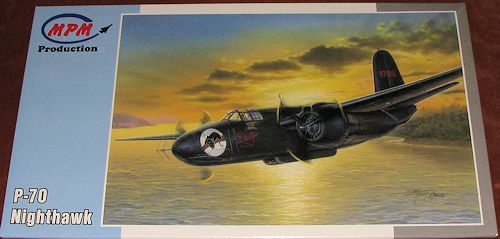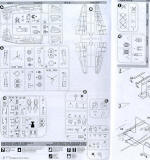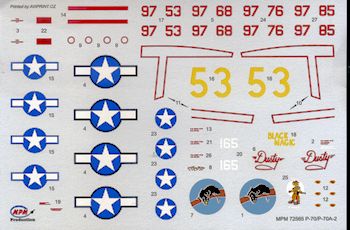
MPM 1/72 P-70 Nighthawk
| KIT #: | 72565 |
| PRICE: | $42.00 SRP |
| DECALS: | Four options |
| REVIEWER: | Scott Van Aken |
| NOTES: |

| HISTORY |
In October 1940, the USAAC felt a need for long-range fighters more than attack bombers, sixty of the production run of A-20s were converted to P-70 night fighters, all delivered by September 1942. They were equipped with SCR-540 radar (a copy of the British AI Mk IV), the glazed nose often painted black to reduce glare and hide the details of the radar set, and had four 20 mm (.79 in) forward-firing cannon, each provided with 120 rounds, in a tray in the lower part of the bomb bay, while the upper part held an additional 250 gal (946 ltr) fuel tank. In 1943, between June and October, 13 A-20Cs and 51 A-20Gs were converted to P-70A. Differences were to be found in the armament, with the 20mm cannon package replaced by an A-20G gun nose with six .50 caliber guns installed, the SCR-540 radar installation being carried in the bomb bay with the transmitting antenna protruding between the nose guns. Further P-70 variants were produced from A-20G and J variants. The singular airframe P-70B-1 (converted from an A-20G) and subsequent P-70B-2s (converted from A-20Gs and Js) had American centimetric radar (SCR-720 or SCR-729) fitted. The P-70s and P-70As saw combat only in the Pacific during World War II and only with the USAAF. The P-70B-1 and P-70B-2 aircraft never saw combat but served as night fighter aircrew trainers in the US in Florida and later in California. All P-70s were retired from service by 1945.
From what I have read, the P-70 was a rather unsuccessful night fighter. It was slow to reach the altitude of many Japanese intruders and was not fast enough to catch them in a tail chase. There were also issues with the high humidity of the southwest Pacific wreaking havoc with the electronics. There were successes, but they were very few.
| THE KIT |
 MPM
has released a series of A-20 derivatives and apparently they have had some
success in sales. I have never bought one as the $40+ price tag has kept me at
bay. But when I saw the P-70 version released, I found one on deep discount and
had to add it to my collection to replace my ancient Revell P-70.
MPM
has released a series of A-20 derivatives and apparently they have had some
success in sales. I have never bought one as the $40+ price tag has kept me at
bay. But when I saw the P-70 version released, I found one on deep discount and
had to add it to my collection to replace my ancient Revell P-70.
Molded in MPM/Special Hobby's usual light grey plastic, the external details are excellent, as they should be as MPM has had nearly 25 years to improve from their early days. They still show their short run roots by having some small ejector towers on larger pieces like the inside of the wings and fuselage, but they have moved up by having alignment pins on many of the parts, nicely injected clear bits vice vacuform, and there is no resin or photo etch for the smaller parts.
As you might expect, the cockpit and radar operator's position are nicely detailed with all the proper bits and pieces. A set of decal belts would have been nice, but you'll need to hit up aftermarket for that. There is no life raft supplied which is too bad as this was very prominent when the pilot's hatch was opened. Despite being land based, these planes frequently had to fly over water so I would think one would be standard equipment.
Before going further, I should mention that though the box says 'P-70', it is apparent that you can also do a P-70B. As mentioned in the historical section, the P-70A/B moved all the radar gear to the bomb bay. Not sure if it also kept the belly gun pack or not as the B was only used as a trainer.
There are differences in the noses used, the antenna arrangement, and the engine carb intakes depending on which markings option you are doing. Interestingly, all of the serial numbers are within 32 of each other ranging from 9753 to 9785. This tells me none of the options is a P-70A so none should have guns in the nose. In fact, the instructions tell you to do some filling on one of the solid nose options (the lone P-70B).
The rest of the kit is pretty straight-forward in terms of what is supplied. This one will need a lot of nose weight (10 grams), so it is fortunate that there is a lot of room for it. Despite the fragile appearance of the main gear, it will be very sturdy once all the parts are glued together.
Markings are provided for four aircraft, all in overall
flat black. The instructions recommend lightening or darkening the color
for the rud der
and elevators as some are freshly painted while others are quite faded. I would
recommend using something like a very dark grey (like RLM 66) for the airframe
so these differences can be seen. The first option is for the box art plane of
the 6 NFS, det A in New Guinea during 1943. This one has a painted over 'glass
nose' and is named 'Dusty' thanks to a nose gear failure during one landing.
Next is a solid nose P-70B from the 481 NFOTG in Florida. This has the newer
centimetric radar so has none of the various antennas of the other options.
Third is a rather unremarkable plane of the 6NFS, also from 1943. It has a solid
nose, but with the antennas. Finally, we have yet another 6 NFS plane from det A
in late 1943. This one also has a solid nose with antennas and carries a small
nose art on the left side. The decal sheet is very nicely printed and contains
the red wing walk areas and warning stripes used on these planes. Please note
that the insignia are the proper shade of blue but I adjusted the colors on the
sheet to show the white bits more clearly.
der
and elevators as some are freshly painted while others are quite faded. I would
recommend using something like a very dark grey (like RLM 66) for the airframe
so these differences can be seen. The first option is for the box art plane of
the 6 NFS, det A in New Guinea during 1943. This one has a painted over 'glass
nose' and is named 'Dusty' thanks to a nose gear failure during one landing.
Next is a solid nose P-70B from the 481 NFOTG in Florida. This has the newer
centimetric radar so has none of the various antennas of the other options.
Third is a rather unremarkable plane of the 6NFS, also from 1943. It has a solid
nose, but with the antennas. Finally, we have yet another 6 NFS plane from det A
in late 1943. This one also has a solid nose with antennas and carries a small
nose art on the left side. The decal sheet is very nicely printed and contains
the red wing walk areas and warning stripes used on these planes. Please note
that the insignia are the proper shade of blue but I adjusted the colors on the
sheet to show the white bits more clearly.
| CONCLUSIONS |
I do realize this kit may be a bit pricey for many, but it is what many of us have come to realize is the 'new norm' for the price of model kits of this size and complexity. I do have to say that MPM has done a very good job of providing a lot of detail in this one and while I would not expect a trouble free build (there is always something), if the instructions are followed in terms of what to fill and what to trim, the result will be a very nice model.
| REFERENCES |
http://en.wikipedia.org/wiki/P-70_%28fighter%29#Variants
2013
Thanks to me for providing the preview kit.
If you would like your product reviewed fairly and fairly quickly, please contact the editor or see other details in the Note to Contributors.